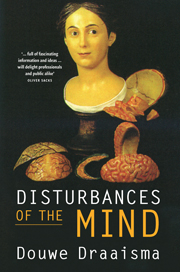Book contents
- Frontmatter
- Contents
- Introduction
- 1 Towards dusk the images appear
- 2 A tormenting round of tremors
- 3 Phineas Gage’s posthumous stroll
- 4 The Celestine prophesy
- 5 Sparks from a Leyden jar
- 6 Siberian brandy
- 7 Go to hell, idiot! Gilles de la Tourette syndrome
- 8 A labyrinth of tangles
- 9 The Mercator of neurology
- 10 The headquarters of madness
- 11 A cup of tea for the doppelgänger
- 12 Little professors
- 13 The Cardan suspension of science
- Index
- References
Introduction
Not the Draaisma syndrome
Published online by Cambridge University Press: 05 March 2014
- Frontmatter
- Contents
- Introduction
- 1 Towards dusk the images appear
- 2 A tormenting round of tremors
- 3 Phineas Gage’s posthumous stroll
- 4 The Celestine prophesy
- 5 Sparks from a Leyden jar
- 6 Siberian brandy
- 7 Go to hell, idiot! Gilles de la Tourette syndrome
- 8 A labyrinth of tangles
- 9 The Mercator of neurology
- 10 The headquarters of madness
- 11 A cup of tea for the doppelgänger
- 12 Little professors
- 13 The Cardan suspension of science
- Index
- References
Summary
Sometimes memories don’t take on meaning until years later. As a college student, I used to work weekends in an old people’s home. One of my responsibilities was the bread cart: towards the end of the afternoon I did the rounds of the rooms, together with a geriatric assistant, delivering the day’s cold meal. If someone was visually handicapped or had trouble walking, we also laid the table. One afternoon, as we were rummaging in the cupboard of one of the residents for china and cutlery, the lady suddenly announced that there was a little man outside in the garden. A little man? We followed her gaze. There was nothing unusual in the garden. But she insisted: ‘There’s a little man there.’ I looked to see if there was anything she could have mistaken for a man. I saw a lamp-post among the bushes, about a metre high, with a cap that looked vaguely like a hat. ‘Do you mean that lamp over there?’ ‘Of course not! I can see it’s a lamp!’ We assured her that neither of us saw anyone outside. As the assistant pushed the woman’s chair closer to the table, she rolled her eyes and tapped her forehead with one finger. At the time, that seemed to me a satisfactory explanation. We called out a cheery ‘Enjoy your meal!’ and continued on our way.
It was some twenty years later that I read about quite a rare syndrome that affects mainly older people with failing eyesight. They begin seeing things – usually images of people, often miniaturized. They appear just as twilight falls and it starts to go quiet. The phenomenon, which is quite harmless, is called Bonnet syndrome. It is named after Charles Bonnet, a Swiss naturalist and philosopher, who in 1760 was the first to describe these images. Bonnet hadn’t seen them himself; he had been told about them by his grandfather, who began seeing images of people when he was almost 90, after several failed cataract operations.
- Type
- Chapter
- Information
- Disturbances of the Mind , pp. 1 - 10Publisher: Cambridge University PressPrint publication year: 2009



